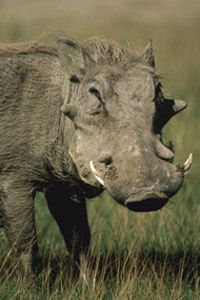Quck answer
Warthogs have warts because they serve a purpose: to protect the animal during fights with other warthogs. The thick skin and tough hide of the warthog is covered in large, rough warts that act like armor, absorbing the impact of blows from rivals. Additionally, the warts contain nerve endings that allow the warthog to sense its environment, including the presence of predators. Despite their unsightly appearance, the warts are an important adaptation for the survival of the warthog in its natural habitat.
Wild Animals

Warthogs may not be the most attractive animals, but their unique features make them interesting. Their facial warts, which can grow up to 4.7 inches (12 centimeters), are a defining characteristic. Despite their unsightly appearance, the warts are not useless. While both males and females have two pairs of large tusks, the lower tusks are particularly sharp and can be used to fend off predators. The upper tusks, on the other hand, are used in fights between males during mating season. Surprisingly, warthogs rarely get injured during these fights due to their thick, fleshy warts, which serve as a form of protection. In fact, the size of a warthog’s warts can even indicate its sex: males have two large warts beneath the eyes and two smaller ones above the mouth, while females have two small warts below their eyes.
Boars have warts that act as a form of protection during fights with other males, similar to the padding worn by football players. These warts shield their face and eyes from the impact when they charge with their sharp tusks. Female warthogs, who do not fight each other, have fewer warts as they don’t require as much protection. Male warthogs tend to be solitary when not competing for mates, while females may live in groups up to 40 and take advantage of abandoned holes for shelter and protection from extreme temperatures. They also use these holes as hideouts and defend them with their tusks when threatened. Sows typically have no more than four piglets at a time, with each piglet having exclusive access to a teat. For more information on warthogs and other animals with unique features, check out the links provided.
FAQ
1. What are warthogs?
Warthogs are a species of wild pig found in Africa. They are known for their large size, distinctive facial features, and impressive tusks.
2. Why are they called warthogs?
Warthogs get their name from the large warts that protrude from their faces. These warts are actually thick pads of skin that protect their faces when they are rooting in the ground for food.
3. Do all warthogs have warts?
Yes, all warthogs have warts. These warts are more prominent in males than in females and are used by males as a way to intimidate rivals during mating season.
4. Do the warts serve any purpose?
Yes, the warts on a warthog’s face serve several important purposes. They protect the warthog’s face from injury while it is rooting around in the ground for food, they help to regulate body temperature, and they are used as a way for males to assert dominance during mating season.
5. Are the warts contagious?
No, the warts on a warthog’s face are not contagious. They are caused by an overgrowth of skin cells and are not caused by any virus or bacteria.
6. Can the warts be removed?
Technically, the warts on a warthog’s face could be removed, but it would not be advisable to do so. The warts serve important purposes for the warthog’s health and well-being, and removing them could cause more harm than good.
7. Are warthogs endangered?
Warthogs are not currently considered endangered, but they are facing threats from habitat loss and hunting. In some areas, warthogs are hunted for their meat and for sport.
8. Where can I see warthogs?
Warthogs can be found in several national parks and game reserves in Africa. Some popular places to see warthogs include Kruger National Park in South Africa, Serengeti National Park in Tanzania, and Maasai Mara National Reserve in Kenya.





Leave a Reply